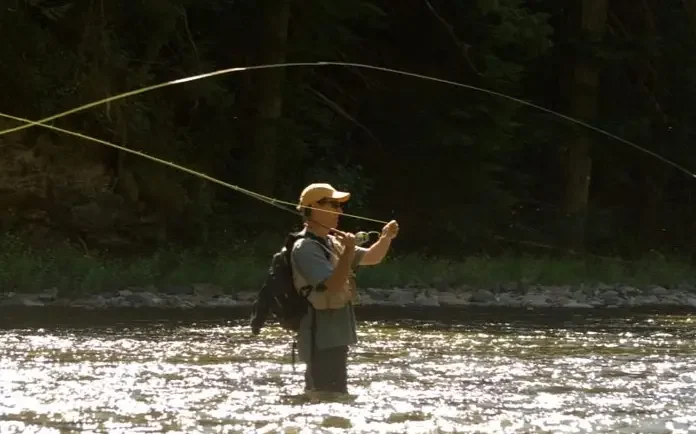There was a time when the St. Joe River was considered a hidden gem, a secret haven for native westslope cutthroat trout that few anglers knew about. That time has come and gone. The St. Joe River, which cuts a 150-mile track across the upper Idaho Panhandle, might be remote, but it’s anything but a secret.

Since it was “discovered” by the general population in the 1970s, the St. Joe River has earned a reputation as one of Idaho’s finest cutthroat streams.
St. Joe River fly fishing isn’t about chasing trophies—trout here mostly measure 12 to 16 inches, though giants are sometimes caught—it’s about pursuing a beautiful native game fish in an equally beautiful setting. If you want to experience the simple joy of catching westslope cutthroats that are abundant and often more than willing to cooperate, then the St. Joe River is nigh unbeatable.
Best Access Points on the St. Joe River
The St. Joe River originates at St. Joe Lake, high in the Bitterroot Mountains near the Montana state line. It flows northeast across the Panhandle until it empties into Coeur d’Alene Lake. The lower part of the river is broad and deep, and almost all of the fly fishing takes place on the upper 50 miles or so.
The Spruce Tree Campground near Avery is a popular access as well as a useful point of reference for exploring the river. The 39-mile stretch of the St. Joe River downstream of the Spruce Tree Campground to the confluence with the North Fork are paralleled by St. Joe River Road. This stretch offers abundant access, including several additional National Forest campgrounds.
It is also by far the most popular section for fishing, especially in the uppermost 15 miles between Spruce Tree and Gold Creek (below Gold Creek, the river is more suited to rafting than fly fishing). Above Spruce Tree Campground, the St. Joe River is roadless, but it is followed by a hiking trail for a further 26 miles. The farther up you go, the fewer other anglers you will see.
When to Fly Fish the St. Joe River
Summer is the best time to fish the St. Joe River, though there’s also a case to be made for fishing in spring or fall to beat the crowds. After Labor Day, you might not see a soul on the roadless section above Spruce Tree. Keep in mind that the North Idaho fly fishing season can be brief; lingering snow and heavy runoff make fishing a difficult prospect before June.
In spring, cutthroat trout from areas farther downriver migrate upstream toward the upper St. Joe and its tributaries to spawn. Most of them stay in the upper stretch of the river all summer, sharing space with the “local” fish that live in the upper river year-round. The migrant cutthroats eventually head back downriver in September.
St. Joe River Fly Fishing Tips & Best Patterns
The St. Joe River is picture-perfect fly fishing water, with beautiful green-tinted pools, lively riffles and swift runs shaded by pines, spruces and firs that grow on steep hillsides. Most of the upper St. Joe is 30 to 50 feet wide and strewn with rocks and boulders, so be prepared for slippery conditions.
Anglers accustomed to matching the hatch with scientific precision will find the St. Joe River surprisingly forgiving. The native cutthroats will key in on a specific hatch from time to time, but as a general rule, they’re opportunists, and not terribly discerning ones at that.
The St. Joe is an excellent dry fly river, and classic patterns work wonders here. Stimulators, Renegades, Adams, Elk Hair Caddis, Hoppers, Humpies, Royal Wulff and Chubby Chernobyl are regular favorites. Keep a few standard nymphs handy too, like Prince Nymphs and Hare’s Ears.
That being said, there are prolific hatches, and it’s wise to offer the fish something that resembles what they’re accustomed to eating. Watch for Blue Winged Olives, March Browns, Skwala Stonefliess and Salmonflies early in the season, followed by Pale Morning Duns, Green Drakes, Golden Stoneflies, Yellow Sallies and Green Sedge Caddis into summer. Grasshoppers and ants are big in summer too (good news for “hopper/dropper” fans). In fall, BWOs return along with Mahogany Duns and October Caddis.
The St. Joe River has populations of sculpins and other baitfish, which are food for larger cutthroats as well as elusive bull trout. Streamer flies might not get as many strikes here as dries and nymphs, but they tend to select for the biggest fish in the river.
Conservation & Fly Fishing Regulations on the St. Joe River
Fishing for cutthroat trout is strictly catch-and-release on the entire length of the St. Joe River and its tributaries. From the confluence of the North Fork St. Joe River upstream, only artificial lures and flies with single barbless hooks may be used.
Statewide regulations—including a daily limit of six—apply to rainbow trout, which are also present in the St. Joe River but are much less abundant than cutthroats. Native bull trout must be released immediately if caught. See the complete Idaho Fish & Game regulations here. The upper St. Joe River also has National Wild and Scenic River designation.
